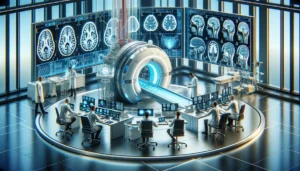Traumatic brain injuries (TBI), ranging from mild concussions to severe head traumas, affect millions globally. In 2023, TBI research has made significant strides in understanding, diagnosing, and treating these injuries. Here’s a look at the latest developments:
Deep Brain Stimulation Research
Stanford Medicine researchers have pioneered a deep brain stimulation technique for treating moderate to severe TBI cognitive impairments. The deep brain stimulation device, a significant advancement in TBI treatment, involves surgically implanting a device into the patient’s brain. This device delivers targeted electrical stimulation to specific brain regions affected by the injury.
The stimulation is tailored to each patient’s unique needs, addressing the specific networks subdued due to the injury. In 2023, this device showed promise in restoring cognitive abilities such as focus, memory, and mood regulation in patients with moderate to severe TBIs. Patients like Gina Arata, who received the implant, reported substantial improvements in cognitive functions that had been impaired by their injuries.
This device marks a crucial step in personalized neurology, offering a novel approach to treating long-lasting impairments from brain injuries.
Repair Protein in Athletes Research
A Johns Hopkins study revealed high repair protein levels, TSPO, in former NFL athletes’ brains, persisting years after injuries. TSPO, part of the brain’s repair mechanism, indicates ongoing brain injury and repair processes. This finding is crucial for understanding long-term cognitive problems like memory loss associated with sports-related mild TBIs.
The discovery of high levels of the repair protein, 18 kDa translocator protein (TSPO), in the brains of former NFL athletes is a significant advancement in understanding traumatic brain injuries (TBI) in athletes. TSPO is involved in the brain’s inflammatory response and facilitates repair after brain injury. Its prolonged presence, years after the athletes have retired, suggests ongoing brain injury and repair processes. In addition, this finding sheds light on the long-term cognitive issues, such as memory loss, that athletes may face due to repeated mild brain injuries incurred during their sports careers.
Soccer Heading and Brain Function
The study presented at the Radiological Society of North America (RSNA) linked soccer heading — hitting the ball with the head — to a decline in brain microstructure and function over two years. The 2023 research involved 148 young adult amateur soccer players, assessing their verbal learning, memory, and brain microstructure using diffusion tensor imaging (DTI). The study found that players with high levels of heading exposure showed changes similar to those in mild traumatic brain injuries. This was the first study to demonstrate long-term changes in brain structure related to sub-concussive head impacts in soccer. This highlights the potential long-term risks associated with sports involving repetitive head impacts.
Penn Medicine’s $8M Biomarker Research
Penn Medicine received an $8 million grant from the Department of Defense for researching biomarkers for traumatic brain injury (TBI). This project aims to identify new biomarkers that can better understand the underlying pathology of different brain injuries and their symptoms. The goal is to develop treatments targeting specific brain damage forms, which could lead to faster recovery and prevent the long-term effects of TBI. This research represents a shift from treating TBI based on symptom severity to addressing specific types of brain injuries, potentially leading to more effective and personalized treatment approaches.
BOOST-3 Clinical Trial
The BOOST-3 clinical trial, funded by the National Institutes of Health, is a $32 million project aimed at improving outcomes for patients with severe traumatic brain injury (TBI). This multi-institutional trial compares two strategies for monitoring and treating TBI patients in the intensive care unit. One strategy is guided by treatment goals based on intracranial pressure and brain tissue oxygen, while the other is based solely on intracranial pressure. Also note the trial’s unique aspect is that it involves patients who cannot give consent due to their severe condition, addressed through an Exception from Informed Consent (EFIC) policy
Eye-Safe Laser Technology
The eye-safe laser technology developed by the University of Birmingham is a novel diagnostic device designed to detect traumatic brain injury (TBI). This hand-held device uses a class 1, CE-marked, eye-safe laser and a unique Raman spectroscopy system. It scans the back of the eye, particularly the optic nerve, which reflects the brain’s condition due to its close linkage. And then, by detecting changes in protein and lipid biomarkers in the optic nerve, the device can indicate brain health and the presence of TBI. Hence, this technology is poised to improve the timeliness and accuracy of TBI diagnosis, particularly in critical situations like the immediate aftermath of an injury.
2023 TBI Research In Summary
2023 TBI research has been monumental in advancing our understanding of TBIs. These developments offer hope for better outcomes for TBI patients, from innovative treatment methods like deep brain stimulation to groundbreaking diagnostic tools. As research continues, it brings us closer to more effective, personalized treatments and a deeper understanding of the long-term impacts of these injuries.






